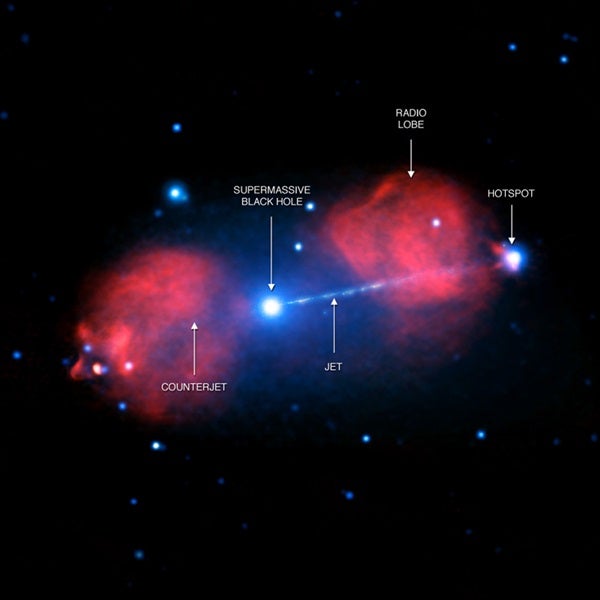The Pictor A Galaxy is one such impressive object. This galaxy, located nearly 500 million light-years from Earth, contains a supermassive black hole at its center. A huge amount of gravitational energy is released as material swirls towards the event horizon, the point of no return for infalling material. This energy produces an enormous beam, or jet, of particles traveling at nearly the speed of light into intergalactic space.
To obtain images of this jet, scientists used NASA’s Chandra X-ray Observatory at various times over 15 years. Chandra’s X-ray data (blue) have been combined with radio data from the Australia Telescope Compact Array (red) in this new composite image.
By studying the details of the structure seen in both X-rays and radio waves, scientists seek to gain a deeper understanding of these huge collimated blasts.
The jet — to the right — in Pictor A is closest to us. It displays continuous X-ray emission over a distance of 300,000 light-years. By comparison, the entire Milky Way is about 100,000 light-years in diameter. Because of its relative proximity and Chandra’s ability to make detailed X-ray images, scientists can look at detailed features in the jet and test ideas of how the X-ray emission is produced.
In addition to the prominent jet seen pointing to the right in the image, researchers report evidence for another jet pointing in the opposite direction, known as a “counterjet.” While tentative evidence for this counterjet had been previously reported, this new Chandra data confirm its existence. The relative faintness of the counterjet compared to the jet is likely due to the motion of the counterjet away from the line of sight to Earth.
The labeled image shows the location of the supermassive black hole, the jet, and the counterjet. Also labeled is a “radio lobe” where the jet is pushing into surrounding gas and a “hotspot” caused by shock waves — akin to sonic booms from a supersonic aircraft — near the tip of the jet.
The detailed properties of the jet and counterjet observed with Chandra show that their X-ray emission likely comes from electrons spiraling around magnetic field lines, a process called synchrotron emission. In this case, the electrons must be continuously re-accelerated as they move out along the jet. How this occurs is not well understood.
The researchers ruled out a different mechanism for producing the jet’s X-ray emission. In that scenario, electrons flying away from the black hole in the jet at near the speed of light move through the sea of cosmic background radiation (CMB) left over from the hot early phase of the universe after the Big Bang. When a fast-moving electron collides with one of these CMB photons, it can boost the photon’s energy up into the X-ray band.
The X-ray brightness of the jet depends on the power in the beam of electrons and the intensity of the background radiation. The relative brightness of the X-rays coming from the jet and counterjet in Pictor A do not match what is expected in this process involving the CMB, and effectively eliminate it as the source of the X-ray production in the jet.










